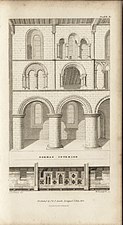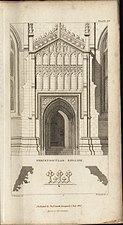Thomas Rickman
Thomas Rickman | |
|---|---|
| Born | 8 June 1776 |
| Died | 4 January 1841 (aged 64) Birmingham, England |
| Nationality | English |
| Occupation | Architect |
Thomas Rickman (8 June 1776 – 4 January 1841) was an English architect and architectural antiquary who was a major figure in the Gothic Revival. He is particularly remembered for his Attempt to Discriminate the Styles of English Architecture (1817), which established the basic chronological classification and terminology that are still in widespread use for the different styles of English medieval ecclesiastical architecture.
Early life
Rickman was born on 8 June 1776 at Maidenhead, Berkshire, into a large Quaker family. He avoided the medical career envisaged for him by his father, a grocer and druggist, and instead went into business for himself. He married his first cousin Lucy Rickman in 1804, a marriage that estranged him from the Quakers.[1]
Antiquarian activities
The failure of his business dealings in London and the death of his first wife left Rickman despondent: the long walks into the countryside that he took for his state of mind were the beginning of his first, antiquarian interest in church architecture. All his spare time was spent in sketching and making careful measured drawings,[2] and classifying medieval architecture, at first through its window tracery, into the sequence that he labelled "Norman" "Early English", "Decorated English" and "Perpendicular English", names that have remained in use, which he was already employing in his diaries[a] in 1811; he gained a knowledge of architecture which was very remarkable at a time when little taste existed for the beauties of the Gothic styles. In 1811 alone he is said to have studied three thousand ecclesiastical buildings.[2] In September that year he gave the first of a series of lectures on medieval architecture at the small Philosophical Society of Liverpool, which he had joined. In around 1812 he wrote an essay on Chester Cathedral, which was published posthumously in 1864.[3][4]
The first publication to appear during his lifetime was an article on Gothic architecture for Smith's Panorama of Arts and Sciences (Liverpool). This was separately published in 1817 as An Attempt to Discriminate the Styles of English Architecture from the Conquest to the Reformation,[5] the first systematic treatise on Gothic architecture and a milestone in the Gothic Revival. It ran through many editions and provided the basis of Rickman's public reputation. He was elected a Fellow of the Society of Antiquaries in 1829.
Rickman's architectural practice

As an architect, Rickman was self-taught. In 1812 he met John Cragg an ironmaster based in Liverpool, and they collaborated on the design of three churches that made extensive use of cast iron: St. George's Church, Everton; St. Michael's Church, Aigburth; and St Philip's Church (since demolished) in Hardman Street.[3][7]
When in the Church Building Act of 1818 a large grant of money was set by the government to build new "Waterloo churches", Rickman sent in a design of his own which was successful in an open competition; thus he was fairly launched upon the profession of an architect, for which his natural gifts strongly fitted him. Rickman then moved to Birmingham where he designed the St George's Church (demolished in 1960) for the city.[2] The design also consisted of churchyard gates, completed in 1822, which remain today.[8] By 1830 Rickman had become one of the most successful architects of his time. He built churches at Hampton Lucy, Ombersley, and Stretton-on-Dunsmore, St George's at Birmingham, St Philip's, St Mary the Virgin and St Matthew's in Bristol, two in Carlisle, St Peter's and St Paul's at Preston, St David's in Glasgow, Grey Friars at Coventry, St Michael's Church, Aigburth and many others. He also designed New Court of St John's College, Cambridge, a palace for the bishop of Carlisle, and several large country houses.[2]


Rickman attracted a large share of the Church Building Commission's patronage in the new churches built in the West Midlands pursuant to the Church Building Act of 1818. Rickman's transitional Gothic style, that later designers looked down on as "Church Commissioners' Gothic",[7] did not stand the more rigorous scrutiny of better-informed historicists in the age of photography. According to the Encyclopædia Britannica Eleventh Edition, "[his churches] are all in the Gothic style, but show more knowledge of the outward form of the medieval style than any real acquaintance with its spirit, and are little better than dull copies of old work, disfigured by much poverty of detail."[2] A later, more generous critic, Sir Howard Colvin, has remarked "He was no ecclesiologist. If the detailing of his buildings was unusually scholarly, the planning remained Georgian, and the total effect of most of his churches is thin and brittle, if by no means unattractive."[9] Rickman nevertheless played an important part in the revival of taste for medievalism, perhaps second only to Pugin.[2]
Henry Hutchinson partnered with Rickman in December 1821 and formed a practice called Rickman and Hutchinson. Rickman remained in this practice until Hutchinson's death in 1831.[10]
Personal life
Rickman was married three times: first to his cousin, Lucy Rickman of Lewes; secondly to Christiana Hornor; and thirdly to Elizabeth Miller of Edinburgh, by whom he had a son, the architect Thomas Miller Rickman (1827–1912), and a daughter.[2] He was a Quaker for most of his life. Though officially estranged after his first marriage, he continued to attend meetings, and was re-admitted prior to his second marriage.[1] Late in his life, he became a member of the Catholic Apostolic (Irvingian) Church[3]
Death and burial

Rickman died at Birmingham on 4 January 1841. He was buried in the churchyard of the church he had designed: St George's Church. His tomb, designed by R. C. Hussey and completed in 1845, still stands, although the church does not.[8]
Major works
- St George's Church, Everton 1813
- St Michael's Church, Aigburth 1813
- Gwrych Castle, Abergele 1819–20
- Old Town Hall, Clitheroe 1820[11]
- Church of St Thomas, Birmingham (war damaged 1940, now St. Thomas' Peace Garden) 1826–1829
- Bank for Birmingham Banking Company (later Midland Bank), Temple Row, Birmingham 1830.[12]
- Holy Trinity Church, Lawrence Hill 1832
- Our Lady of Mount Carmel Church, Redditch 1834, his only Catholic church.[13]
- Keeper's Lodge, Audley End, Essex 1835
- St Stephen's Church, Sneinton 1837
- Bishop Ryder Church, Birmingham 1838
- Rose Castle (alterations), Cumbria
See also
- List of new churches by Thomas Rickman
- List of church restorations and alterations by Thomas Rickman
- List of non-ecclesiastical works by Thomas Rickman
Notes
References
- ^ a b Kerr, Alex (1985). "Thomas Rickman in France". In Blamires, David; Greenwood, Jeremy; Kerr, Alex (eds.). A Quaker Miscellany for Edward H. Milligan. Manchester: David Blamires. pp. 111–120. ISBN 0-9510152-1-4.
- ^ a b c d e f g Chisholm 1911.
- ^ a b c Aldrich, Megan (2009) [2004]. "Rickman, Thomas (1776–1841)". Oxford Dictionary of National Biography (online ed.). Oxford University Press. doi:10.1093/ref:odnb/23607. (Subscription or UK public library membership required.)
- ^ Rickman, Thomas (1864). "On the architectural history of Chester Cathedral". Journal of the Architectural, Archaeological, and Historic Society for the County, City and Neighbourhood of Chester. 2: 277–288.
- ^ a b Rickman, Thomas (1817). An attempt to discriminate the styles of English architecture, from the Conquest to the Reformation; with notices of eight hundred English buildings: preceded by a sketch of the Grecian and Roman orders. London: Longman, Hurst, Rees, Orme, and Brown.
- ^ Historic England. "Church of St Peter Ad Vincula (1382119)". National Heritage List for England. Retrieved 7 May 2007.
- ^ a b Webster, Christopher (2017). "Late Georgian Churches: 'Absolutely Wretched' or the Triumph of Rational Pragmatism?". Architectural History. 60: 147–181. doi:10.1017/arh.2017.5. JSTOR 26449615. S2CID 194816840.
- ^ a b Douglas Hickman (1970). Birmingham. Studio Vista Ltd.
- ^ H. Colvin, A Biographical Dictionary of British Architects 1600–1840 3rd ed. sub "Thomas Rickman", p 813.
- ^ Leslie Stephen (1896). Dictionary of National Biography. Smith, Elder. p. 267.
- ^ Historic England. "Town Hall (1072374)". National Heritage List for England. Retrieved 4 August 2021.
- ^ Ballard, Phillada (2009), Birminghams Victorian & Edwardian Architects, Oblong for the Birmingham and West Midlands Group of the Victorian Society, ISBN 978-0-9556576-2-7
- ^ Historic England, Redditch - Our Lady and Mount Carmel, Taking Stock, retrieved 14 June 2022
Sources
- Howard Colvin, 1993. A Biographical Dictionary of British Architects 1600–1840 3rd ed.
- This article incorporates text from a publication now in the public domain: Chisholm, Hugh, ed. (1911). "Rickman, Thomas". Encyclopædia Britannica. Vol. 21 (11th ed.). Cambridge University Press. p. 315.
External links
 Works by or about Thomas Rickman at Wikisource
Works by or about Thomas Rickman at Wikisource
- 1776 births
- 1841 deaths
- People from Maidenhead
- Gothic Revival architects
- English ecclesiastical architects
- English Quakers
- Fellows of the Society of Antiquaries of London
- Members and Associates of the Royal Birmingham Society of Artists
- English antiquarians
- English architectural historians
- 19th-century antiquarians
- Architects from Berkshire




